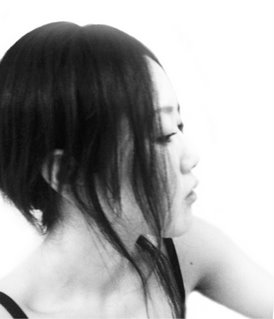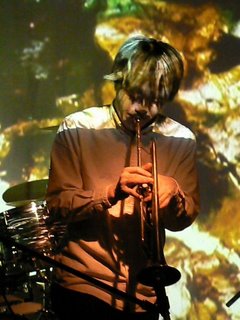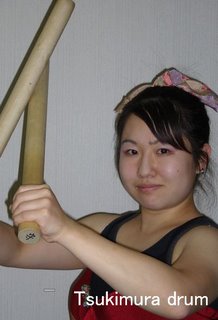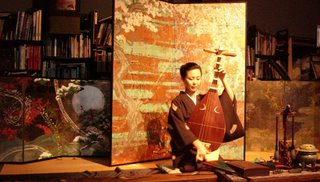Saturday, November 18, 2006
Saturday, November 11, 2006
Invisible Line to SEEds Ikebana Show

See invisibles. Irony has been used a lot as rhetoric. Is it necessary to see what is not seen? You'd better understand what you can see at first.
Artists must show invisibles off. In Ikebana works, every single plant towards the invisible pivot point. The basic composition shapes with three plants. They stay static equilibrium with asymetric composition. Viewer's eye movement follows invisible line naturally. Pre-established harmony with asymetric but hormonizing makes us feel good. Ikebana organises the universe.
Seiko Nasu will show you the road to his invisible universe.
You will see Seito's Ikebana Show @SEEDS Dec.9th
1st Show start on 21:00
2nd Show start on 24:00
Friday, November 10, 2006
Blues Man from the South Tsubaki Show @SEEDS

Chinese aicent terminology did not define that "not being" is the opposit idea of "being". They undersood that "not being" is being "not be".
God only knows. You might be trustful person if that words occur in mind when you face problems. G.O.K. is a marginal room in making decision and a charm which leads you to rational action in the long run. The respect on the nature raises curiosity and
builds the talent. The art will be given on you, not achieved by your daily practicing. Ascetic practice aims to abandon yourself, not to get something. As long as keeping modest to the nature, the idea will keep coming into you. Well, some might say, "That is not the art". You need to know the limit of human being.
Tsubaki Hanawo(ツバキハナヲ) sings the spinning news out of his body. His split hoarsy voice reminds of smoky morning in Shibuya. Another might recall the solid sound of rain on the rocks in Yakushima island. Either Shibuya or Yakushima island is no different jungle as it is. Tsubaki Hanawo's blues explodes the breathing shout out of the communication to the nature.
See it, here it and smell the "Tsubaki Hanawo" Blues Show @SEEDS"Tsubaki" Dec. 9th around midnight.
Thursday, November 09, 2006
Calligraphic Mystery Tour on SEEDS

Kyuyo Ishikawa dispels calligrapy mysticism with only three words, "Tong, Suh, and Tong". This simile comes across the tinny sound in mind of the brush strokes. He mentions letters used to be inscribed in stones and calligraphy is the imitation of this carving movement of chisel: Brush is the chisel and paper is the stone. "Tong" is the hitting sound of the chisel and "Suh" is the sound of slide of chisel. With Prof. Ishikawa's view point on calligraphy, you can enjoy it more ever.
Another pleasure of calligraphy appreciation is to understand the history of forming them. Prof. Shizuka Shirakawa, respectable philologist and dead in October, was said to be able to recognize its pronounce and meaning when new chinese charactors descovered in the ruins. That is because the chinese character, or Kanji, compoesd with the several figures each of which has original meaning.
Orie Yoshida, a Japanese calligrapher, draws letters on her deep understanding of the chinese charactor world. That gives us deeper enteretainment to see.
Her "Tong, Suh and Tong" sound takes us trip away to the gate of the deep cavern in Chinese Sichuan maountains.
Don't miss the great journey of live calligraphy drawing @SEEDS, Dec. 9th Sat, 21:00 open.
Monday, November 06, 2006
KOBATA Kinds to Viewers

KOBATA's Live Painting @ SEEDS Dec. 9th Sat.
Art needs communication. The paintings music or stages, all of them demand knowledge on them in order to understand. They usually are unkind, reticence, archaic and difficult. They are so self-defensive, getting so nervous on showing their shallowness up. The most inefficial point is that they do not exist unless viewers notice.
When it comes to KOBATA, she is kind to viewers. Kindness to viewers takes her works upper than where supposed to be. KOBATA's live painting works will grow and keep changing with the communication between the viewers. Accrding to Ikujiro Nonaka, the empowerment of "Ba" grows with the accompanied of the interaction of participants.
KOBATA will show on SEEDS Dec.9th
The Sound of Silence Plant KO,DO,NA

KO,DO,NA on Attention, mark up SEEDS Dec. 9th on your calender
Many artists have mentioned about the tube of body phenominon. As Kieth Richrds said before, “Coming down from the sky, then it passes through the body and get out of it, that is music." Whether you have the fear of "Nature" or not is the litmus paper for the trustable person, or not.
You want a beatutiful melody, then it gone. If you reproduce the sound of nature, it must go over the temperament. It is inevitable that KO,DO,NA choose the trumpet as his instrument to express. He needs the waving sound because what in his brain is filled with the sound of silence, which our ear can not listen. Mamoru Fujieda's great apporoach, "Plant Aspect(Syokubutsu, Monyou)" shows the electric potential music of the plant. KO,DO,NA feels the electricity of Nature, makes it breathing and sound so that we can understand.
Can his body and trumpet spin its sound from the Shibuya underground? The KO, DO,NA's SEEDS first participation, music from past of 0 o'clock.
Must be on your attention.
KO,DO,NA
Kazutaka Kuroki (黒木一隆、the trumpet and the pianica, electronics, the guitar) due to the solo unit. After the participating in “Ohmimi network”, joined "Kara Gumi" as actor. “BULLETS/COEXIST”, Nishi Azabu you can get his cool performance.
Friday, November 03, 2006
Cristmas Sparkling Beat @SEEDS Tsubaki



A few walks after getting off a bus, banging sound was surfing on the autumn wind to my ear. I saw three girls jumping and druming inside an old school campus beyond the red leaves falling. Japanese generation y girls band, "Daka-Daka" (打花打火)made a cool round.
Norika Kizaki(木崎詔甲), drum player on the center photo, told, "We wanna spread taiko, or drum, music out among the young people." She started her career with her father drumming team and has seeked for the chance to let the youngs experience a Japanese style beat music. Who invited her was double Michiko's who met in a high school days and have kept good relationship based on the harmonization of both musical talent. Ms. Yamada(山田路子), on flute, said, "We beat too much sometimes" The name of team named after thier play style, like fire works pump upon sky. Three of them, however, can't be seen fervent players before starting reharsal.
Ms. Tsukimura(月村路子) uttered "So-y-ya" and Kizaki started fervarish beat on two of drums. Tsukimura's beat was electrical deep and Kizaki's Yamada's was jumpin g sparkling. Yamada's flute caught me incredibly miraculous. Like Mr.Crapton's Slow hands, her accurate finger handling was too fast to see. More than her technique, her tone out of flute was incredible and impressive.The mellow gold refrain of Yamada's flute on the champagne drum on beat harmonized and took you to the fractale splashing world of sound with gas.
"Daka-Daka" created The fresh red red wine music for the premiere christmas present.
Daka-Daka's "talking 'bout my generation" debut on @ SEEDS, Dec. 9th. with proudly offered
Yanaka Blues in Biwa
 In raining Yanaka district, the old town Tokyo, the sound from a hundred years old tranquil house led me to the "Yanaka Biwa, Japanese lute, style" concert. One lady of austere wearing kimono was sitting silence, with her eyes close. Pine floor was filled with the greenry incent and people who waited for Nobuko Kawashima's luring tour to Edo lute dream.
In raining Yanaka district, the old town Tokyo, the sound from a hundred years old tranquil house led me to the "Yanaka Biwa, Japanese lute, style" concert. One lady of austere wearing kimono was sitting silence, with her eyes close. Pine floor was filled with the greenry incent and people who waited for Nobuko Kawashima's luring tour to Edo lute dream.Nobuko Kawashima, one of the precious Japanese lute player, has a concert every two month in Yanaka. She said, "Yanaka is the best place to listen biwa play. So I want people to enjoy not only music but this atmosphere down here" She has started "Yanaka Biwa Style" concert two years ago. "Yanaka has still friendly community where neighbors knows and give a help if you need" She thinks that this ambient area life has a good effect on her expression.
Biwa play reminds of the blues shouting at the corner of down the south French Quarter, New Orleans. Like Muddy Waters play, Ms. Kawashima inspired us of her deep voice as well as lute's sound. Her growling hoarse maintained the astonished red wine fregrance. The sound of picking strings and banging lute body with her alt voice waives the meticulous persian carpet.
The Japanese lute, biwa, was introduced here after the long journey on the Silk road. A dry blue sky with the cow bell ringing can imagin in the biwa sound she pulled. Yanaka Biwa Style trace back the mother culture of Japan, spinning new blues style.
Oh, mama, you can't end the Yanaka Blues again. Liberize prowling to stuck inside a bustling mobile.
Don't miss a great opportunity for the refuge of bustle. Yanaka Biwa Blues @SEEDS Tokyo Impact on Dec. 9th. see this blog for more info.
Nobuko Kawashima (川嶋信子)
http://blogs.yahoo.co.jp/ken55ken1010/

Subscribe to:
Posts (Atom)